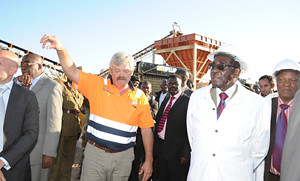
Republic of Zimbabwe President Robert Mugabe went on a fact-finding tour through two diamond mining projects in the Southern African nation. Zimbabwe is reported to be a large-scale depository of diamonds., a photo by Pan-African News Wire File Photos on Flickr.
Zim not running out of surface diamonds
Sunday, 03 November 2013 00:00
Prince Mushawevato
Zimbabwe Sunday Mail
Government has dismissed claims that the country is fast running out of alluvial diamonds, saying current deposits are yet to be fully exploited and new fields have not yet been fully explored. In an interview with The Sunday Mail Business last week, Deputy Minister of Mines and Mining
Development Mr Fred Moyo said the surface diamonds were still far from being exhausted given the timeframe that the local diamond mining firms have been in operation.
“Naturally, the surface ores will be exhausted first. However, it is important to note that the area in Chiadzwa has not been fully exploited. We cannot exhaust the deposit of this nature in just five years of operations,” he said.
Zimbabwe is presently ranked among the top 10 diamond-producing countries in the world.
The majority of the world’s important kimberlite mines such as Alrosa (Russia) and De Beers have now moved into full underground mining, an indication of depletion of the precious mineral. And Zimbabwe, if not frustrated by the West, which has been throwing spanners in the country’s diamond trade, stands to significantly benefit as underground mining that is more expensive and complex might result in traditional suppliers failing to meet production targets.
According to a report released by the Companies Diamond Industry Series recently, Zimbabwe is projected to satisfy up to 30 percent of world diamond demand by 2015.
Marange and Chiadzwa diamonds, which are being mined in an area covering over 120 000 hectares, are closer to the ground and mined through the open-cast system.
However, some of the diamond-mining companies operating in Zimbabwe that include Marange Resources, Anjin and Diamond Mining Company (DMC) have invested in new equipment meant to venture into future underground mining.
Experts said the move did not indicate exhaustion of alluvial diamonds but was a way of guaranteeing sustained operations for the companies. Deputy Minister Moyo said there was nothing wrong with the companies planning for future operations.
“The diamond area has not been fully explored. There is still much of the resource to be tapped both through alluvial and underground mining,” he said.
Chairman of activist group Resource Exploitation Watch Mr Tafadzwa Musarara said the country still had a long way to go before it exhausted its alluvial diamonds.
“There is no way that the alluvial diamonds could have been exhausted in such a short space of time. According to a 2011 report presented to the Kimberley Process (KP) that convened in Kinshasa for an annual plenary meeting, Chiadzwa is the world’s biggest diamond find in recent memory.
“Given the quantities in question, you get to realise that the diamond-mining companies operating in Marange and Chiadzwa could not have exhausted the mineral in just three years, given the time the report was produced and the challenges they (diamond-mining companies) face in mining the mineral, especially during the rainy season,” he said.
“Moreover, more deposits are being discovered in different areas around the country that include Bikita, meaning surface diamonds are still in abundance,” Mr Musarara added. Zimbabwe is expected to earn about US$700 million from the sale of the precious stones this year, with a record 16,9 million carats set to be produced from Marange.
Production statistics from the KP show that Zimbabwe officially produced 3,8 million carats valued at US$174,8 million between the years 2003 to 2009, and 8,5 million carats in 2010.
Meanwhile, Mr Moyo said the adverse performance of commodities on the global markets was having a direct impact on the performance of the local mining industry.
The global price of minerals such as gold, platinum and diamonds is determined by economic powerhouses that include the United States, China, Japan, Germany and Russia. “The mining sector is influenced on both internal and external platforms. But it is the external factor of depressed commodity prices that are bedevilling the sector most right now. Internal challenges have remained those of capitalisation and costs. The industry is battling with these, but they are not new challenges,” he noted.
No comments:
Post a Comment